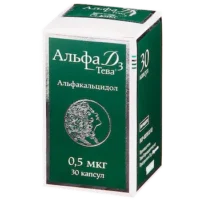Description
Ibandronic Acid Coated Tablets 50 mg. №30blis
Ingredients:
Each coated tablet contains 50 mg of Ibandronic acid.
Mechanism of Action:
Ibandronic acid is a nitrogen-containing bisphosphonate that selectively inhibits osteoclastic bone resorption. It binds to hydroxyapatite crystals in bone and is internalized by osteoclasts, leading to their apoptosis and ultimately reducing bone resorption.
Pharmacological Properties:
Ibandronic acid is a potent inhibitor of bone resorption. It has a high affinity for hydroxyapatite crystals, allowing it to target bone tissue specifically. The drug is not metabolized and is excreted unchanged in the urine.
Indications for Use:
Ibandronic acid is indicated for the treatment and prevention of osteoporosis in postmenopausal women. It helps increase bone mineral density and reduce the risk of fractures.
Contraindications:
Do not use Ibandronic acid if you have a history of hypersensitivity to bisphosphonates, severe renal impairment, or abnormalities of the esophagus that delay esophageal emptying. It is contraindicated in patients who cannot stand or sit upright for at least 60 minutes.
Side Effects:
Common side effects of Ibandronic acid may include gastrointestinal disturbances, musculoskeletal pain, and flu-like symptoms. Rare but serious side effects may include osteonecrosis of the jaw and atypical femoral fractures.
Usage Instructions:
The recommended dosage is one tablet (50 mg) once daily, preferably at the same time each day. The tablet should be swallowed whole with a full glass of plain water at least 60 minutes before the first food or drink of the day. Patients should not lie down for at least 60 minutes after taking the tablet.
Benefits Compared to Analogues:
Ibandronic acid offers the advantage of once-daily dosing, which improves patient compliance. Its potent anti-resorptive effects and proven efficacy in reducing fracture risk make it a preferred choice for osteoporosis treatment.
Suitable Patient Groups:
Ibandronic acid is suitable for postmenopausal women with osteoporosis. It is not recommended for use in children, adolescents, or pregnant women due to limited safety data in these populations. Caution is advised when prescribing to elderly patients, especially those with impaired renal function.
Storage and Shelf Life:
Store Ibandronic acid tablets in a cool, dry place away from direct sunlight. Keep the tablets in their original packaging to protect them from moisture. Check the expiry date on the packaging and do not use the tablets after this date.
Packaging Description:
Ibandronic acid tablets are supplied in blister packs containing 30 tablets. Each tablet is coated for easy swallowing and protection of the active ingredient.
Scientific Evidence:
Ibandronic acid has been extensively studied in clinical trials, demonstrating its efficacy in reducing the risk of fractures in postmenopausal women with osteoporosis. Research has shown that Ibandronic acid inhibits bone resorption by osteoclasts, leading to an increase in bone mineral density and a decrease in fracture risk.
Additional Information:
It is important to follow the dosage instructions carefully and to avoid lying down for at least 60 minutes after taking Ibandronic acid to prevent esophageal irritation. Consult your healthcare provider before starting Ibandronic acid to ensure it is the right treatment for your osteoporosis.





